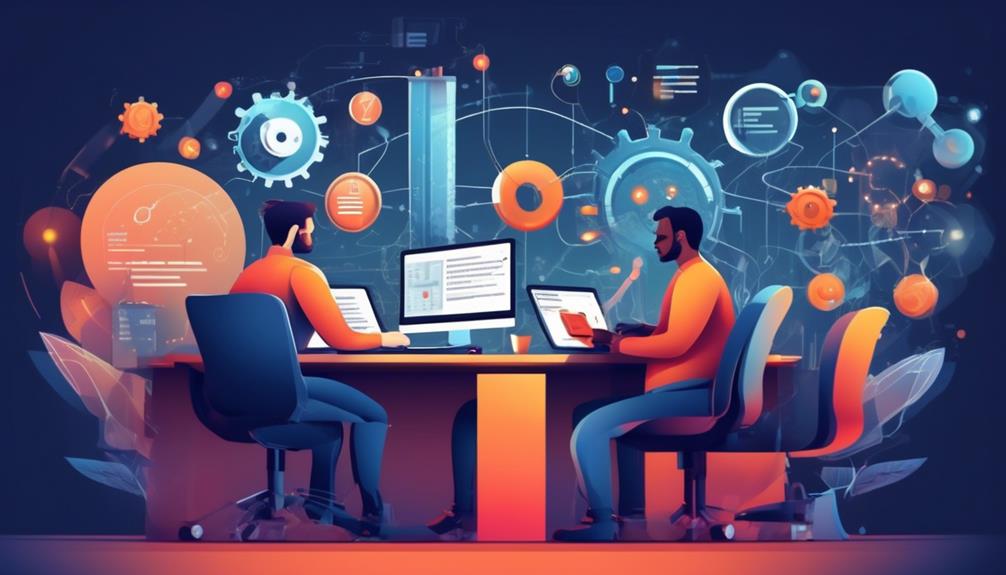Moving from manual processes to hyperautomation involves mapping your workflows, starting small with pilot projects that incorporate AI and RPA. Identify tasks ripe for automation and gradually build integrated systems that connect multiple processes. Upskill your team, foster change management, and develop a clear strategy focused on smarter, adaptive operations. Prioritizing continuous improvement guarantees you stay competitive. Keep exploring, and you’ll discover how this transformation can revolutionize your organization’s efficiency and innovation.
Key Takeaways
- Begin with small pilot projects integrating AI and RPA to identify suitable automation areas.
- Map existing workflows to understand processes and pinpoint automation opportunities.
- Develop a strategic roadmap focusing on end-to-end automation and interconnected systems.
- Invest in workforce training to upskill employees for collaborating with intelligent automation tools.
- Continuously monitor, adapt, and optimize automation initiatives to enhance efficiency and maintain competitive advantage.

Have you ever wondered how businesses are transforming their operations with technology? It’s no longer enough to rely on manual processes or simple automation; today, organizations are shifting towards hyperautomation—an advanced approach that combines AI integration, robotic process automation (RPA), and other intelligent technologies to streamline workflows and boost efficiency. This transition isn’t just about upgrading tools; it’s about fundamentally rethinking how work gets done and preparing your workforce for the new digital landscape.
The first step in this journey is understanding that AI integration plays a pivotal role in enabling hyperautomation. AI doesn’t just automate repetitive tasks; it enhances decision-making, predicts outcomes, and adapts to changing conditions. When you embed AI into your existing systems, you unleash the potential for smarter automation that can handle complex processes once thought to require human intervention. This shift requires a mindset change—seeing AI not as a replacement but as an augmentation of your team’s capabilities. As you integrate AI, you’ll find that your workforce transforms from manual operators to strategic thinkers who manage and oversee intelligent systems. This is workforce transformation in action—your employees shifting focus from mundane tasks to higher-value activities, fostering innovation and growth.
Moving forward, you’ll need to map out your current workflows and identify areas ripe for automation. Start small—pilot projects that incorporate AI and RPA—so you can evaluate impact and make adjustments. As you progress, aim for end-to-end automation where possible, connecting different systems and data sources for seamless operations. This is where hyperautomation truly shines; it’s not just about automating individual tasks but creating an interconnected ecosystem of intelligent processes that operate continuously and adaptively.
Your workforce will need training and support to thrive in this environment. Upskilling becomes essential as your employees learn to work alongside AI tools, interpret insights generated by automation, and troubleshoot issues when they arise. Embrace change management strategies to guarantee a smooth transition—communicate clearly, involve teams early, and highlight the benefits of hyperautomation. The goal is to foster a culture that sees automation as an enabler rather than a threat, empowering your staff to focus on more strategic, creative, and customer-centric work.
Ultimately, moving from manual processes to hyperautomation is a strategic journey that demands a clear roadmap, technological investment, and a focus on workforce transformation. When you combine AI integration with a forward-thinking approach to skills development, you position your organization to thrive in a rapidly evolving digital economy. This isn’t just automation for automation’s sake; it’s about creating smarter, more agile operations that deliver sustained competitive advantage. Recognizing the importance of color accuracy in projectors can also be a critical factor when creating a compelling visual environment for your digital transformation initiatives.
Frequently Asked Questions
What Industries Benefit Most From Hyperautomation?
You’ll find that industries like healthcare, finance, and manufacturing benefit most from hyperautomation. It boosts industry-specific efficiencies by streamlining complex processes and reducing manual effort. Plus, hyperautomation helps guarantee regulatory compliance by automating audit trails and reporting. This technology enables you to operate more smoothly, cut costs, and improve accuracy, making it a game-changer for sectors where precision and compliance are critical.
How Long Does a Typical Automation Transition Take?
The automation shift timeline varies based on your organization’s size and complexity. Typically, it takes several months to a year, depending on your change planning and how quickly you realize automation ROI. You should focus on clear milestones, testing, and employee training. By carefully planning each phase, you guarantee a smoother move, maximizing benefits and minimizing disruptions. Patience and strategic execution are key to a successful automation journey.
What Are Common Challenges During Hyperautomation Implementation?
Imagine steering a stormy sea—hyperautomation implementation faces similar waves. You might struggle with change management, as employees resist new workflows, and data security concerns, risking breaches. These challenges can slow progress and cause setbacks. Staying adaptable, communicating clearly, and prioritizing security measures help you steer through. Addressing these issues early ensures smoother sailing toward the benefits of hyperautomation, making your journey more successful and less turbulent.
How Is Employee Training Handled in Automation Upgrades?
When upgrading to automation, you handle employee training by developing thorough training programs that focus on new tools and processes. You can incorporate employee onboarding sessions to familiarize staff with automation features, ensuring smooth adaptation. Providing hands-on practice, ongoing support, and clear documentation helps employees feel confident. This approach minimizes resistance and boosts productivity, making the shift seamless and effective for everyone involved.
What Are the Future Trends in Automation Technology?
Sure, future automation trends will have AI integration taking center stage, making robots smarter and more intuitive. You’ll see ethical concerns rise as machines make decisions, prompting debates on morality and accountability. Expect hyperautomation to evolve with even more seamless workflows, reducing human intervention. But don’t worry, your job’s safe — until AI decides to write its own job descriptions, that is!
Conclusion
Now that you understand the journey from manual processes to hyperautomation, imagine streamlining your customer service with AI chatbots and robotic process automation. For instance, a retail giant reduced response times by 50% and improved customer satisfaction through automation. Embracing this roadmap isn’t just about efficiency; it’s about transforming your business to stay competitive. Take the leap today—your future self will thank you for it.









